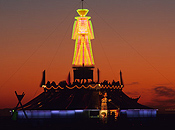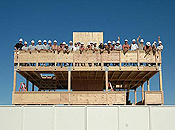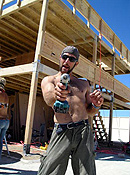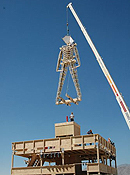The Rotating Man
The crew had a terrifically successful year in 2005 designing, fabricating, and finally installing the Man and its rotating mechanical apparatus. This year’s project brought a new level of complexity. The need for the Man to rotate required extensive communication between the pedestal designers and a cadre of mechanical engineers long before the first piece of wood was cut or metal machined. A very successful collaboration brought together a wide variety of knowledge regarding stress load and mechanical advantage then applied that information in a way that had never been done before. The result was a 40-foot tall wooden sculpture that could be adjusted to rotate effortlessly atop a 35-foot tall pedestal, also known as the Man’s Base.
The Man’s Base
Platform, Man Base, A-Frame, Lighthouse, Pyramid, Observatory, Funhouse, Pavilion . . . What ever it may have been called, the support structure or base for the Man has gone through many different manifestations. It has evolved over the 20 years of the Burning Man event.
 When the Man arrived in the Black Rock Desert in 1990, it was positioned directly on the surface of the ground, as it had been previously on Baker Beach in San Francisco. In 1996, as the Black Rock City population grew, the need became apparent that the Man needed to rise higher to be visible to participants camping farther away, and the first platform came to be. To make sure that the platform would burn, and to provide comfortable seating, it was surrounded by bales of straw, making a perfect fuel to feed the fire. Each year, this simple platform grew taller and incorporated more bales of straw.
When the Man arrived in the Black Rock Desert in 1990, it was positioned directly on the surface of the ground, as it had been previously on Baker Beach in San Francisco. In 1996, as the Black Rock City population grew, the need became apparent that the Man needed to rise higher to be visible to participants camping farther away, and the first platform came to be. To make sure that the platform would burn, and to provide comfortable seating, it was surrounded by bales of straw, making a perfect fuel to feed the fire. Each year, this simple platform grew taller and incorporated more bales of straw.
In 2001, the next leap in the platform’s evolution established a structure designed to support the yearly art theme. This innovation started a trend to incorporate the theme and increasing interactivity into the platform design.
More creativity, energy, and design integration went into the concept of the pedestal where the Man would stand. Clearly, the design was headed for more connection to the yearly theme and how the platform could interact with Burning Man participants.
- 2001 – The Seven AgesThe Man’s base took the form of an enormous board game, where participants were encouraged to interact with different theme camps to have their passports stamped, giving them access to what became known as the A-Frame.
- 2002 – The Floating WorldThe art theme asked how we find our way through the world and what we seek and value in it. The treasure to be sought in the Unknown would take the form of gold doubloons imprinted with the likeness of the Burning Man. Possession of this treasure, and the surrendering of it, entitled the bearer to enter the Lighthouse and climb upward to the spinning world immediately beneath Burning Man.
- 2003 – Beyond BeliefBeyond the dogmas, creeds, and metaphysical ideas of religion, there is immediate experience. It is from this primal world that living faith arises. The Beyond Belief art theme explored this mystery, inviting participants to create interactive rites, ritual processions, elaborate images, shrines, icons, temples, and visions. A pyramid made a perfect base for the Man.
- 2004 – Vault of HeavenThis theme blended scientific theory and artistic intuition. The Man stood upon the apex of a dome arising from a classical entablature supported by a series of gleaming white columns. This large, circular building resembled an observatory. The pillars at the outside of its base formed a colonnade, each pair framing the proscenium of a miniature theatre designed for the performance of “off-planet” theatre. Participants were encouraged to create impromptu performance.
- 2005 – Psyche; The Conscious, the Subconscious, and the UnconsciousKnown as the Funhouse, the Man’s base supported the art theme in an ever more elaborate way.Quoting from the 2005 Art Theme text, it’s noted that “[W]e will unfurl a circus tent that overspreads a many-chambered maze. This carnival of consciousness will house a freak show of the self. Each interactive room will indicate a different mood, a different mask; a different mode of being we assume as players in the masquerade that’s called a personality.
 “The figure will be raised upon a pedestal with four stout spokes protruding from its base. By pushing on these poles, participants may turn the Burning Man, slowly rotating the four-story figure that looms over them. Those who labor at this turnstile will be physically connected to its sovereign axis, the irreducible core of the “I”. But for many other citizens throughout our city, this fitful movement of the Man will feel erratic and profoundly disconcerting.”
“The figure will be raised upon a pedestal with four stout spokes protruding from its base. By pushing on these poles, participants may turn the Burning Man, slowly rotating the four-story figure that looms over them. Those who labor at this turnstile will be physically connected to its sovereign axis, the irreducible core of the “I”. But for many other citizens throughout our city, this fitful movement of the Man will feel erratic and profoundly disconcerting.”
And the Man did turn, thanks to a cooperative effort from the participants. Strangers worked together to make the Man turn.
On the desert those who build the Man and its base are but one crew. Leading up to arrival in Black Rock City, they work with separate focuses, construction schedules, and materials needs. Somewhere in the middle, they meet by way of the riggers.
Successes
The construction staff for the Man base has evolved though the years. In 2005, designers developed plans for the structure and the maze. A structural engineer made real blue prints of the structure, stamped with the engineer’s seal, for the first time. A mechanical engineer helped to check the design of the turnstile mechanism. A construction specialist joined the effort to help assemble the prefabricated tower parts.
 Many of these successes resulted from effective communication between the many members of this team. The first ever Man/Base Summit meeting in March brought together 20 members of the core team, construction teams for the Man and platform, pyrotechnics, neon, artist advocate, designers, and others. This initial meeting set the tone for the rest of the year, with regular contacts communicating designs, timelines, logistics, changes, budgets, and material requests. All the elements communicating together ensured that the team would work as efficiently as possible.
Many of these successes resulted from effective communication between the many members of this team. The first ever Man/Base Summit meeting in March brought together 20 members of the core team, construction teams for the Man and platform, pyrotechnics, neon, artist advocate, designers, and others. This initial meeting set the tone for the rest of the year, with regular contacts communicating designs, timelines, logistics, changes, budgets, and material requests. All the elements communicating together ensured that the team would work as efficiently as possible.
Some fabrication and assembly has taken place at the Black Rock Station work ranch in the past, but the complexity of the 2005 structure meant that it had to be mostly prefabricated so that on-site assembly could be compressed into the first week of site occupancy. In fact, the main tower was up in 3 days! This great success allowed the Man to be lifted into place several days earlier than in the past so that the turning mechanism could be installed and finely tuned.
This work made 2005 a phenomenal year for the Man base, arguably the best, most interactive platform ever! So much art and so many different groups working together in a limited time could have ended in disaster, but instead a sense of friendship, unity, and support emerged. It was as if many of the challenges inherent on the playa didn’t exist.
Maze artists felt taken care of and loved the placements of installations. They felt honored by the special opportunity to be at the base of the Man.
Participants loved the experience mixing a maze with interactive art. Several people have mentioned how they visited more than once to continue to explore and enjoy the art.
Sideshow performers, 999 Eyes Circus, and Reverend Billy took the Man base to a whole new level. The quality and quantity of the art was impressive, but performers at the entrances helped to create a mood, a sense of the experiences inside. It was a great testament to the theme and how the theme could be owned, explored, and perceived by everyone.
Funhouse Wranglers were the guardians of the Funhouse. They guided those who were lost with a fun and humorous attitude, encouraging a richer and more meaningful experience within the maze.
Challenges
 Clearly, 2005 raised the bar for design of the Man’s base! The Funhouse was such a great success as a structure, as interactive art, and as a community project with very few construction snags. Future crews will be hard pressed to make it better. Everyone is committed to try.
Clearly, 2005 raised the bar for design of the Man’s base! The Funhouse was such a great success as a structure, as interactive art, and as a community project with very few construction snags. Future crews will be hard pressed to make it better. Everyone is committed to try.
As always some new challenges have emerged:
- Friday night early closing–All good things must come to a close. Preparation for Saturday night’s festivities require that the Man base must close at midnight on Friday, so the dismantle team can do their job. Removal of the art and a majority of the maze structure takes about 8 hours to complete, and this must happen before the pyrotechnics team begins working. No one wants to tell people that they waited too late to visit the platform. Better communication will get this message out to participants.
- Maintenance–The Funhouse was arguably one of the most visited areas on the playa, and this traffic created some wear and tear on the structure. Once the event started, the crew from the Department of Public Works (DPW) was officially done working on the platform. While the maze looked great, it felt the pounding of thousands of feet going through every day. One challenge was to find someone to help make necessary repairs each day. Maintenance proved to be a daily job for the rotating Man crew, as well. Staff worked throughout the event adjusting the guide wires, making sure the bearing assemblies were working properly, and keeping contact points properly lubricated to ensure good operation. Much like carnival workers, these adventurous souls climbed atop the ride to tune and tweak the monumental beast with wrenches and grease each day of its operation.
- Security–While the Rangers on duty and Funhouse Wranglers did a great job working with traffic flow and safety concerns, some of the art installations were vandalized, even early in the week. While a maze is intrinsically difficult to monitor, perhaps future plans can cover off potential roadblock areas and protect other areas like the flagpoles. Many participants were climbing up them by kicking against the wall in that room. They couldn’t easily see that in doing so they were hurting some of the art. Possibly signage could improve the situation.
- Emergency access–Working with Emergency Services personnel and the local authorities was also a challenge. As these stakeholders hadn’t been included in planning before the event, hasty improvisation was needed to cover issues they viewed as basic security needs. These people will be more involved in planning for 2006, so the problem should be easily rectified.
- Mechanics–Engineering challenges were expected, evident, and not very interesting. The design addressed the constraints of structural integrity, wind loads, shear movement, and just the plain old unknown magic of the playa. The crew had to approach the problem with the innocence of a child tempered with the knowledge of craftsperson who had built such an imposing structure year after year. Their work met this challenge well.
- Design–In building a monstrous project like the rotating Man, failure must be designed into the apparatus. Design analysis identified the weakest point directly where human interaction joined with the Man, at the oars. This expectation turned out to be accurate, since two of the oars used to rotate the Man did break. Cutting all of the oars to a shorter length proved to add the last refinement needed to the overall device.
The Man crew faced by far its most technically challenging year in 2005. They were assigned the task of building the 40-foot icon as usual, but making it rotate was also on their list of things to do. Building an object so large out of wood, knowing that it will rotate freely just a few feet over thousands of people, was a decidedly new wrinkle in this familiar project.
Why rotate what you can lift? That’s right, “Up yours!” says the Man. The giant sculpture will be lifted and lowered in 2006 by yet another complicated mechanical apparatus. Fantastic algorithms, not human steam, will determine the Man’s moments of waxing and waning.
The Man team will carry many important lessons forward into 2006. First among them is this: Reach beyond what well-educated engineers say is possible and have faith in your own judgment as well as your team.
Submitted by
Ben Stoelting, Crimson Rose, Will Roger, Beth Scarborough


